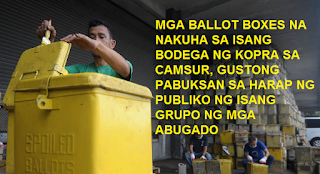Ash Wednesday: Toxic Ash Donated by PNP-CIDG Contains Burned Shabu, Marijuana, other Drugs
Churchgoers at San Roque Cathedral in Caloocan City mysteriously ended up with rashes or blisters on their forehead, the spot which the priest marked with a cross on Ash Wednesday using ashes donated by the police.
Caloocan Bishop Pablo Virgilio David said he will ask help from Caloocan City PNP-CIDG because it was them who donated the ash.
David said the church staff was also puzzled, even as he assured the public that the church had already extended assistance to the affected churchgoers.
“We apologize for whatever harm inadvertently caused by what should have been a solemn ritual marking the beginning of Lent,” the prelate said on Friday.
Meanwhile, Caloocan City CIDG spokesman Police Senior Inspector Romulo Macasadia said he already ordered an investigation of possible sabotage because he suspected that the ash was taken from the CIDG’s incinerator – a place where confiscated illegal drugs are being burned.
“We are conducting an investigation if the ashes came from our incinerator. Ash from incenerators are acidic and toxic because these are burned illegal drug,” Macasadia said.
The police officer also mentioned that some of its members are angry towards CBCP so a possible sabotage has not been ruled-out.
Some churchgoers said they felt a burning or stinging sensation after they had their foreheads marked with the ash. Those who immediately washed off the ash in the church’s bathroom noticed reddish rashes or blisters.
“Strangely, others who lined up for the imposition of ashes by other lay ministers didn’t experience the same thing,” David said.
David said the results of the laboratory tests showed that the ashes had a high level of acidity, or a PH level of almost 14.
A level 14 PH can burn human skin according to experts. Authorities are still analyzing the ash while the CIDG continue its internal investigation.
Police who gave the ash to the Caloocan City catherdal has not been identified as of press time.
Caloocan Bishop Pablo Virgilio David said he will ask help from Caloocan City PNP-CIDG because it was them who donated the ash.
David said the church staff was also puzzled, even as he assured the public that the church had already extended assistance to the affected churchgoers.
Loading...
Meanwhile, Caloocan City CIDG spokesman Police Senior Inspector Romulo Macasadia said he already ordered an investigation of possible sabotage because he suspected that the ash was taken from the CIDG’s incinerator – a place where confiscated illegal drugs are being burned.
“We are conducting an investigation if the ashes came from our incinerator. Ash from incenerators are acidic and toxic because these are burned illegal drug,” Macasadia said.
The police officer also mentioned that some of its members are angry towards CBCP so a possible sabotage has not been ruled-out.
Some churchgoers said they felt a burning or stinging sensation after they had their foreheads marked with the ash. Those who immediately washed off the ash in the church’s bathroom noticed reddish rashes or blisters.
“Strangely, others who lined up for the imposition of ashes by other lay ministers didn’t experience the same thing,” David said.
David said the results of the laboratory tests showed that the ashes had a high level of acidity, or a PH level of almost 14.
A level 14 PH can burn human skin according to experts. Authorities are still analyzing the ash while the CIDG continue its internal investigation.
Police who gave the ash to the Caloocan City catherdal has not been identified as of press time.
Loading...



Comments
Post a Comment